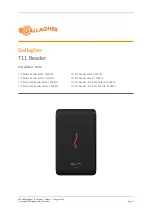
Osprey PCI User Guide
ViewCast
85
The filtergraph is as follows:
The Osprey Timecode Filter resides in the module TCOverlay.ax and is installed and registered as
part of the standard driver installation. The source code for this filter is included in the Osprey
AVStream SDK.
The Osprey Timecode Filter also exposes to applications a custom property and callback function
that allows it to return the VITC data for each frame along with the frame’s timestamp to the
application. Since use of this capability requires custom programming it will not be further
discussed here. Refer instead to the
Osprey AVStream SDK Use
rs’ Guide
. A sample SDK applet
named TCApp illustrates the interface.
Figure 60. Timecode Video Making
Timecode stamping must be enabled in the driver before it can be used, and the field and line
number correctly set. The Osprey 530/540/560, unlike the Osprey 100 and 200 series devices, does
not implement an autosearch function to find the VITC line. To access the controls, go to the Device
property tab and click
Extras…
It is recommended that timecode marking be disabled when not in use, especially the auto search
feature – on a slow machine it uses several percent of CPU bandwidth - especially if timecodes are
not present.
Note: VITC and LTC – Longitudinal Timecode – are two distinct encoding systems, and this driver
supports only VITC.
A suggested reference on timecode is
Timecode
: a user’s guide – 3rd ed., John Ratcliff, Focal Press,
1999.
Summary of Contents for Osprey PCI
Page 1: ......
Page 6: ......
Page 29: ...Osprey PCI User Guide ViewCast 23 Figure 15 VbiGraph utility...
Page 56: ...Setting Driver Properties 50 ViewCast Figure 35 Extras...
Page 67: ...Osprey PCI User Guide ViewCast 61 Figure 46 Weighting...
Page 70: ...Setting Driver Properties 64 ViewCast...
Page 77: ...Osprey PCI User Guide ViewCast 71...
Page 107: ...Osprey PCI User Guide ViewCast 101...
Page 114: ......
Page 118: ...Appendix C Troubleshooting 112 ViewCast...
Page 125: ......
















































